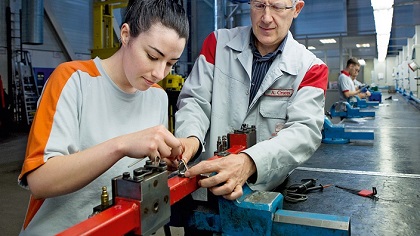
Building upon the junior secondary program, the Berufsschulen are two- and three-year vocational schools that prepare young people for a profession. In the 1992-93 academic year, there were 1.8 million enrolled in these schools. About 264,000 individuals attended Berufsfachschulen, also called intermediate technical schools (ITS). These schools usually offer full-time vocation-specific programs. They are attended by students who want to train for a specialty or those already in the workforce who want to earn the equivalent of an intermediate school certificate from a Realschule. Full-time programs take between twelve and eighteen months, and part-time programs take between three and three-and-one-half years. Other types of schools designed to prepare students for different kinds of vocational careers are the higher technical school (HTS), the Fachoberschule, attended by about 75,000 persons in 1992-93, and the advanced vocational school (AVS), the Berufsaufbauschule, attended by about 6,500 persons in the same year. Students can choose to attend one of these three kinds of schools after graduating with an intermediate school certificate from a Realschule or an equivalent school.
The method of teaching used in vocational schools is called the dual system because it combines classroom study with a work-related apprenticeship system. The length of schooling/training depends on prior vocational experience and may entail one year of full-time instruction or up to three years of part-time training.
Students can earn the Fachhochschulreife after successfully completing vocational education and passing a qualifying entrance examination. The Fachhochschulreife entitles a student to enter a Fachhochschule, or a training college, and to continue postsecondary occupational or professional training in engineering or technical fields. Such programs last from six months to three years (full-time instruction) or six to eight years (part-time instruction). Some students with many years of practical experience or those with special skills may also attend a Fachhochschule.
Vocational education and training is a joint government-industry program. The federal government and the Laender share in the financing of vocational education in public vocational schools, with the federal government bearing a slightly higher share than the Laender. On-the-job vocational training, whose cost is entirely borne by companies and businesses, is more costly to provide than vocational education.
According to the German Federal Institute of Vocational Education and Training (BIBB): Germany’s VET (vocational education and training) system is recognized as a successful model, largely because of the dual system, which leads to high-quality vocational qualifications and enables smooth education-to-work transitions. Although it is definitely at the heart of the German VET system the dual system does not cover all aspects of the German VET system. There have been 490.267 students in the dual system but also 225.590 students who study in so called full-time vocational schools in 2017 (cf. VET Data Report Germany 2017, p. 90). The complete German VET system consists of the elements described below.
Germany’s vocational schools partner with around 430,000 companies, and more than 80 percent of large companies hire apprentices.
According to an Association of German Chambers of Commerce and Industry (DIHK) survey, 516,200 people started apprenticeships in 2015. But this left many positions unfilled. Nearly a third of businesses surveyed were unable to recruit sufficient qualified applicants for their open trainee positions. In eastern Germany, the figure was 45 percent.
Related Articles:
German education system
German Education: An Overview of Excellence and Innovation
List of Universities in Germany
Education in Germany
Elementary and Primary Education in Germany
Secondary Education in Germany
Tertiary or Higher Education in Germany
